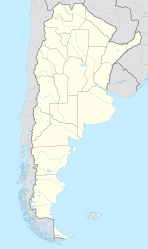Cafayate
| Cafayate | |
|---|---|
| Town | |
| Location of Cafayate in Argentina | |
| Coordinates: 26°5′S 65°58′W / 26.083°S 65.967°WCoordinates: 26°5′S 65°58′W / 26.083°S 65.967°W | |
| Country |
|
| Province | Salta |
| Department | Cafayate |
| Elevation | 1,683 m (5,522 ft) |
| Population | |
| • Total | 11,785 |
| Time zone | ART (UTC-3) |
| CPA base | A4427 |
| Dialing code | +54 3868 |
| Climate | BWk |
Cafayate (Spanish pronunciation: [kafaˈʒate]) is a town located at the central zone of the Valles Calchaquíes in the province of Salta, Argentina. It sits 1,683 metres (5,522 ft) above mean sea level, at a distance of 189 kilometres (117 mi) from Salta City and 1,329 kilometres (826 mi) from Buenos Aires. It has about 12,000 inhabitants (2001 census [INDEC]).
The town is an important tourist centre for exploring the Calchaquíes valleys, and because of the quality and originality of the wines produced in the area. The largest golf course in South America, at 240 acres (0.97 km2), is currently being developed just outside the city center at La Estancia de Cafayate. The town was founded in 1840 by Manuel Fernando de Aramburu, at the site of a mission. In 1863 the Cafayate Department was created, of which Cafayate is the capital.
The Cafayates were a tribe of the Diaguita-Calchaquí group, which, together with the related Tolombón, inhabited the Valles Calchaquíes prior to the arrival of the Spanish Conquistadores. Their language was known as Cacán. Like other Diaguita tribes, they had recently fallen under the influence of the Incas, after a prolonged resistance. They later mounted a fierce resistance to the Spaniards.
Even though most agree that the root of Cafayate is Quechua, the meaning of the term is disputed. Some claim it to mean "Box of Water", others to be a deformation of Capac-Yac ("Great Lake") or Capac-Yaco ("Great Chief" or "Wealthy People"). Another Cacán version understands it as "Grave of Sorrows".
...
Wikipedia

